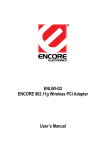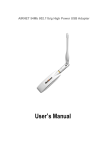Download Alfa Network UBDo-nt User manual
Transcript
UBDo-gt IEEE 802.11bg Wireless Outdoor USB AP/CPE High-Gain Integrated Antenna User Manual TABLE OF CONTENTS OVERVIEW.................................................... 2 UNPACKING INFORMATION ....................................................... 2 Key Features .....................................................................................3 INSTALLATION GUIDE .................................. 4 SOFTWARE INSTALLATION ........................................................ 4 MANAGEMENT GUIDE ................................. 10 MAKING A BASIC NETWORK CONNECTION .................................. 10 Before You Start ..............................................................................10 Ad-Hoc Mode ................................................................................. 10 Infrastructure mode ....................................................................... 12 INTRODUCTION TO THE WIRELESS LAN UTILITY ......................... 14 Starting the Wireless LAN Utility .....................................................14 General............................................................................................15 Profile..............................................................................................16 Available Network ...........................................................................17 Advanced.........................................................................................18 Status ..............................................................................................19 Statistics .........................................................................................20 APPENDIX .................................................. 21 RT-SET SETUP WIZARD......................................................... 21 Connect to a wireless network in infrastructure mode ....................21 Connect to a wireless network in ad hoc mode................................24 Use this adapter as an AP ................................................................27 AP MODE MANAGEMENT GUIDE ................................................ 30 General............................................................................................30 Advanced.........................................................................................31 Statistics .........................................................................................31 SoftAP .............................................................................................32 1 Overview Thank you for purchasing this product. Read this chapter to know about UBDo-gt. Unpacking information Before getting started, please verify that your package includes the following items: 1. UBDo-gt 2. One Utility/ Manual CD 3. USB Y-cable 4. Mounting Ring Introduction to the Installation Using USB cable to connect your computer or notebook and this Outdoor Wireless USB AP/CPE insert the Utility/Manual CD to your computer or notebook and run auto installation program to setup the Utility on your computer or notebook 2 Key Features y Complies with IEEE 802.11b/g wireless standard y Support driver for Windows 98se, Me, 2000 and XP. y Complies with Universal Serial Bus Rev. 1.0, 1.1 and 2.0 specifications. y Supports auto-installation and diagnostic utilities. y High Speed transfer data rate up to 54 Mbps y Support wireless data encryption with 64/128-bit WEP, WPA (TKIP with IEEE 802.1x) and AES functions. y Support turbo mode for 72 Mbps data rate y 3 Installation Guide Software Installation Note: The following driver installation guide uses Windows XP as the presumed operation system. The procedures and screens in Windows 98se, 2000 are familiar with Windows XP. Insert the CD-Rom that came with this product to your CD-Rom drive. The menu window pops up automatically. Please click the “Windows Driver” button of this product. Note: If the CD-Rom fails to auto-run, please click on “My Computer”Æ your CD-Rom Drive Æ UBDo-g folder Æ 8187_1316_win7 for Windows 7 driver then click the “Setup” icon to start the this menu. “My Computer”Æ your CD-Rom Drive Æ UBDo-g folder Æ 8187_1313 for Windows 98/ME/XP/Vista driver then click the “Setup” icon to start the this menu. 4 1. The language-selecting window pops up. Please select the language you use and click OK. 2. The welcome window pops up. Click the “Next” button to proceed. 3. Please wait while installation. 4. This Windows Logo testing warning window may pop up upon installation. Please click the “Contiune Anyway” to continue. 5 5. If you are using Windows 98se or ME, the system may ask for the driver CD. Please click the Browse button. Select your CD-ROM Drive then select USB Æ Driver ÆWin98 (or WINME) to browse the driver. If not, please skip this step. 6. Click the “Finish” button to complete driver and utility installation. 7. For Windows XP and 2000 users, please insert this USB wireless adapter to your 6 computer. If you are using Windows 98se or ME, please restart the system first before connect this wireless adapter to your computer. 8. The “Found New Hardware Wizard“ pops up. (Note: This wizard won’t pop up in Windows 98 and ME. The system finds the new hardware and installs the hardware automatically. Please skip the following steps) 9. Select “No, not this time” and click the “Next” button. 10. Select “Install the software automatically” and then click the “Next” button. 7 11. Please wait while installing the driver. The Windows logo testing warning window may pops up again. Please click the “Continue Anyway” button to continue. 8 12. Click the “Finish” button to complete installation. 9 Management Guide Read this chapter to understand the management interface of the device and how to manage the device. Making a Basic Network Connection Before You Start In the following instruction for making a network connection, we use the utility we provided to configure your wireless network settings. Note: For Windows XP users that want to configure your wireless network using this Utility, please perform the following procedures to disable your native Windows XP wireless support (Wireless Zero Configuration Service) 1. Double click the icon on your desktop to start the utility. 2. Make sure that the “Windows Zero Config” checkbox is unchecked. Ad-Hoc Mode An Ad-Hoc mode wireless network connects two computers directly without the use of a router or AP. It is also know as a peer-to-peer network. For example, we can install this wireless adapter to two computers respectively. The communication between the two computers is an Ad-Hoc mode network. 10 To use this adapter in Ad-Hoc Mode 1. Double click the icon on your desktop. 2. Click the “Available Network” button to scan available wireless network adapters. Double click on the network adapter that you are going to connect to. 3. Click the OK button to confirm that you are connecting to an open wireless network. 4. Click OK to add this network into the profile list. Note: This example is an open wireless network. If you are going to connect to a Wireless adapter with security protection, you will have to configure the encryption settings in this profile to be corresponding to the other wireless adapter. Please click on the “Network Authentication” drop list to select an authentication method, and then select a “Data encryption” type. Fill in each required blanks and click “OK”. 11 Infrastructure mode An Infrastructure Mode network contains at least one wireless client and one wireless AP or router. This client connects to Internet or intranet by communicating with this wireless AP. 12 To use this adapter in Infrastructure Mode: 1. Double click the icon on your desktop. 2. Click the “Available Network” button to scan available access points. Double click on the AP that you are going to connect to. 3. Click the OK button to confirm that you are connecting to an open wireless network. 4. Click OK to add this network into the profile list. 13 Note: This example is an open wireless network. If you are going to connect to an AP with security protection, you will have to configure the encryption settings in this profile to be corresponding to your AP. Please click on the “Network Authentication” drop list to select an authentication method, and then select a “Data encryption” type. Fill in each required blanks and click “OK”. Tip: Windows XP and Windows 2000 users is also allowed to connect to your wireless network with the “RT-Set” setup wizard. Please refer to “Appendix” for more information. Introduction to the Wireless LAN Utility Note: This management instruction uses Windows XP as the presumed operation system. Some functions are not supported in Windows 98se or Windows ME. Starting the Wireless LAN Utility Double click the shortcut on your desktop. The Wireless LAN Utility pops up. You may click on the tabs above to configure this adapter. The checkboxes below provide the following functions: Show Tray Icon Windows Zero Config Radio Off Disable Adapter Check this checkbox to show the utility icon on your system tray, which is in the notification area at the lower-right corner of the windows desktop. You may also uncheck it to remove the utility icon from system tray. Uncheck this checkbox to use native Windows XP wireless support (Wireless Zero Configuration Service) instead of using this utility to configure your wireless network. Check this checkbox to prevent this adapter form transmitting or receiving signals. Uncheck it to communicate. Check this checkbox to disable this wireless adapter. Uncheck it to enable this adapter again. 14 General After starting the utility, the general page pops up This General tab provides the information of your current wireless network connection. You may click the Renew button to refresh those listed information. Status: Check if the device associated to target network. Speed: The current connection speed Type: Infrastructure mode or Ad-Hoc mode. Encryption: The performing encryption mode for connecting to current network profile. SSID: The SSID (network name) of the connected wireless network. Signal Strength: Indicates the signal strength detected by this adapter. Network Address: Shows the current IP addresses settings for this adapter. 15 Profile The Profile tab lists the preferred connections. You can click the buttons beside to do configure each connection. Add Click this button to add a connection profile for this adapter. Remove To remove a connection profile, click this profile on the profile list and click this button to delete it. Edit To modify the configurations for a profile, click this profile on the profile list and click this button to edit. Duplicate To make a copy of a profile, click the profile that going to be copied, and click this button to copy it. Set Default To select a profile as your default wireless connection, click this profile on the list and click this button. You may also double click on each profile to select it as your default wireless connection. 16 Available Network This available tab lists the reachable wireless network of this adapter. Refresh Add to Profile Click this button to rescan available networks around the adapter. To add an available Network to your profile list, select an available network and click this button to add. 17 Advanced This Advanced tab provides advanced configurations to this adapter. Every modification in this tab will be performed after clicking the Apply button. To restore the default settings of the advanced tab, click the Set defaults button to perform restoring. Power Save None Min Max Disable Power saving function. Minimum power consumption Maximum power consumption Turbo Mode OFF ON AUTO Disable turbo mode Enable turbo mode Enable or disable turbo automatically according to the detected environment Fragment Threshold The maximum size of a packet that is going to be segmented and transmitted. Select the size from 256 to 2432(default) bytes. RTS Threshold Select the RTS Threshold form 0 to 2432(default) Wireless Mode 802.11g/b 802.11b Connect to a 802.11g/b network (2.4GHz/54Mbps) Connect to a 802.11b network (2.4GHz/11Mbps) 18 802.11b Preamble Mode Select the preamble mode to be long, short or auto detection mode. Region Domain Select your region from the drop list. Please note that it is necessary for you to select a correct region. Selecting an incorrect region may again the applicable law. Status This tab shows the current connection status of this adapter. 19 Statistics See this tab to show the transmission activity record. Clicking the “Reset” button recounts the values from zero. 20 Appendix RT-Set Setup Wizard For Windows 2000 and XP users to connect to a wireless network easily, we also provide the RT-Set setup wizard to help users set their preferred wireless network step by step. You can configure your wireless network via this RT-Set setup wizard in the following three modes: Station mode (infrastructure): Select this mode to connect to the AP (access point) in your LAN. Station mode (ad hoc): Select this mode to connect to another wireless network adapter in your LAN. AP mode: Select this mode to perform this adapter as an AP (access point). To start the RT-Set Wizard, please click the “RT-Set” tab on the up-left corner of the window Connect to a wireless network in infrastructure mode 1. To connect this adapter to an AP, select the “Station (infrastructure)” mode and click the “Next” button to proceed. 21 2. The RT-Set scans the available AP within your LAN. Those AP are listed with their SSID. Click the wireless AP that you are going to connect with and then click the “Next” button. You may also click the “Refresh” button to scan wireless AP again. 3. The “unsecured network” window may pop up if the AP you select doesn’t use security encryption settings. Click the “OK” button after your confirmation. 4. Click “OK” after configuring the profile content to be corresponding to the AP that you are going to connect with. If you are connecting to an AP without security encryption, please click “OK” button without configuration. 22 5. Configure the IP address for connecting to the network. You may choose “Use the following IP address” to fill in IP addresses manually or choose “Obtain an IP address automatically (recommend)”. 6. After configuring IP addresses, click the “Finish” button to complete. 23 Connect to a wireless network in ad hoc mode 1. To connect this adapter to another computer, select the “Station (ad hoc)” mode and click the “Next” button to proceed. 2. The RT-Set scans the available wireless adapters within your LAN. Those adapters are listed with their SSID. Click the one that you are going to connect with and then click the “Next” button. You may also click the “Refresh” button to scan wireless adapters again. 24 3. The “unsecured network” window may pop up if the adapter you select doesn’t use security encryption settings. Click the “OK” button after your confirmation. 4. Click “OK” after configuring the profile content to be corresponding to the wireless adapter that you are going to connect with. If you are connecting to a wireless adapter without security encryption, please click “OK” button without configuration. 25 5. Configure the IP address for connecting to the wireless adapter. You may choose “Use the following IP address” to fill in IP addresses manually or choose “Obtain an IP address automatically”. 26 Use this adapter as an AP 1. To use this adapter as an AP (access point), select the “AP” mode and click the “Next” button to proceed. 2. Select “Normal User” (recommend) to make an step-by-step configuration. You may also select “Advanced Users” to configure this AP with more detail. 27 3. Assign an SSID for this AP, which is the name that is going to be identified while other wireless devices scan for available network. Choose to use WEP encryption or not from the drop list and click “Next” to proceed. 4. Click the “Next” button after confirming those settings above. 28 5. Click “Finish” to complete setup. 29 AP mode management guide General After configuring the adapter in AP mode, this “General” page shows up, which shows the general information of this AP. SSID: The SSID (network name) of the wireless network constructed by this AP. BSSID: Config: Association Table: The MAC address of this AP Click this button to change configurations to this AP Shows the information of those devices that associated with this AP including their MAC addresses and the time that they connected with this device. 30 Advanced Beacon Interval: DTIM Period: Preamble Mode: Set Defaults: Apply: Define the interval between beacons from 20~1000 Set the DTIM period between 1~255 Click the drop list to select the preamble to be long, short or auto Click this button to restore the settings above to default Click this button to execute changes. Statistics See this tab to show the transmission activity record. Clicking the “Reset” button recounts the values from zero. 31 SoftAP This page allows users to select the adapter for connect to public network. Please click on the device that are used for connecting to public network and click the “Select” button, and then click the “Apply” button to execute. 32










































![4403002491_712_716 menu_EN_A [s]](http://vs1.manualzilla.com/store/data/005650300_1-96030b29e24dd373b0bced3bef593dda-150x150.png)